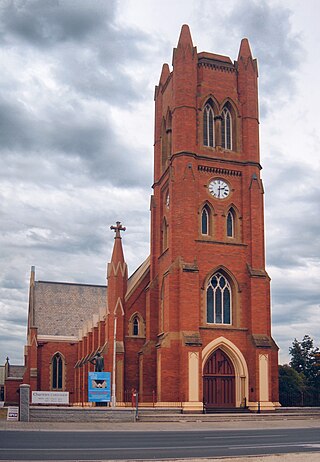
The Anglican Church of Australia, formerly known as the Church of England in Australia and Tasmania, is a Christian church in Australia and an autonomous church of the Anglican Communion. It is the second largest church in Australia after the Catholic Church. According to the 2016 census, 3.1 million Australians identify as Anglicans. As of 2016, the Anglican Church of Australia had more than 3 million nominal members and 437,880 active baptised members. For much of Australian history since the arrival of the 'First Fleet' in January 1788, the church was the largest religious denomination. It remains today one of the largest providers of social welfare services in Australia.

Phillip John Aspinall is an Australian Anglican bishop who served as Anglican Archbishop of Brisbane from February 2002 until December 2022, and was also the Primate of the Anglican Church of Australia from July 2005 until he stood down on 4 July 2014.

The Cathedral Church of St David is the Anglican cathedral church located in Hobart, Tasmania, Australia. The cathedral is the mother-church for the Diocese of Tasmania. Consecrated in 1874, St David's is the seat of the Bishop of Tasmania, currently the Right Reverend Richard Condie. The dean is the Very Reverend Richard Humphrey.

Elizabeth Town is a populated rural area in Meander Valley, Tasmania bisected by the Bass Highway.

The Anglican Diocese of Bunbury is a diocese of the Anglican Church of Australia which was founded in 1904 and covers the south of the State of Western Australia. Together with Perth and North West Australia, it is one of the three diocese of the Province of Western Australia. The diocese's cathedral since 1963 is St Boniface's Cathedral in Bunbury. The current Bishop of Bunbury, since 3 November 2018, is Ian Coutts.
John Lee Archer was the Civil Engineer and Colonial Architect in Van Diemen's Land, serving from 1827 to 1838. During his tenure, Archer was responsible for all Tasmanian government buildings including those for penal and military purposes.
James Blackburn was an English civil engineer, surveyor and architect best known for his work in Australia, where he had been transported as a sentence for forgery. According to the Australian Dictionary of Biography, Blackburn "has claims to be considered one of the greatest engineers of his period in Australia, and his architectural achievements established him as Tasmania's most advanced and original architect." He was key to the formation of the Department of Public Works in 1839, serving as one of its core members under Alexander Cheyne.

Kenneth Herbert Short was an Anglican bishop in Australia. He was the Bishop of Wollongong and then Bishop of Parramatta and Bishop to the Australian Defence Force. He was appointed dean of St Andrew's Cathedral, Sydney in 1989. He was a missionary, pastor and military chaplain.

St Philip's Church, Sydney, is the oldest Anglican church parish in Australia. The church is located in the Sydney city centre between York Street, Clarence and Jamison Streets on a location known as Church Hill, so sometimes called Church Hill Anglican. St Philip's is part of the Diocese of Sydney, Australia. The church is listed on the Register of the National Estate.

St Paul's Cathedral, Bendigo, is an Anglican cathedral church in Bendigo, Victoria, Australia. It is the cathedral church of the Diocese of Bendigo and the seat of the Bishop of Bendigo, presently Matthew Brain.

Henry Hunter (1832–1892) was a prominent architect and civil servant in Tasmania and Queensland, Australia. He is best known for his work on churches. During his life was also at various times a state magistrate of Tasmania, a member of the Tasmanian State Board of Education, the Hobart Board of Health, a Commissioner for the New Norfolk Insane Asylum and President of the Queensland Institute of Architects.
Louis Reginald Williams (1890–1980) was an ecclesiastical architect in Australia. He designed churches throughout the country, particularly in Victoria, primarily Anglican but also Methodists, Presbyterians, Lutherans and Christian Scientists. He himself regarded St Andrew's Anglican Church, Brighton in Melbourne, as his greatest work.

The Garrison Church is a heritage-listed active Anglican church building located at Argyle Street in the inner city Sydney suburb of Millers Point in the City of Sydney local government area of New South Wales, Australia. It was designed by Henry Ginn, Edmund Blacket and built from 1840 to 1846 by Edward Flood and George Patton. It is also known as Holy Trinity Anglican Church and Hall. The property is owned by Anglican Church Property Trust and was added to the New South Wales State Heritage Register on 2 April 1999.
The Tasmanian Heritage Register is the statutory heritage register of the Australian state of Tasmania. It is defined as a list of areas currently identified as having historic cultural heritage importance to Tasmania as a whole. The Register is kept by the Tasmanian Heritage Council within the meaning of the Tasmanian Historic Cultural Heritage Act 1995. It encompasses in addition the Heritage Register of the Tasmanian branch of the National Trust of Australia, which was merged into the Tasmanian Heritage Register. The enforcement of the heritage's requirements is managed by Heritage Tasmania.
Holy Trinity Church is a former Anglican, and now Greek Orthodox, church in North Hobart, Tasmania.

St John's Anglican Church is an Anglican church located in New Town, Tasmania, Australia, is notable for its unbroken record of use as a parish church, from the first service on 20 December 1835 up to the present. The parish is administered by the Anglican Diocese of Tasmania.

St Mark's Church is an active Anglican church in Darling Point, a suburb of Sydney, New South Wales, Australia. It is part of a significant local heritage group that includes the church, rectory, and adjacent cottage. The group forms part of a large collection of important to late 19th century buildings of considerable townscape, historic and cultural significance, including the former St Mark's Crescent School, St Mark's Cottage and Bishopscourt, formerly Greenoaks.

St Luke's Anglican Church is a heritage-listed Anglican church at Elizabeth Drive, Liverpool, Sydney, New South Wales, Australia. It was designed by Francis Greenway and built from 1818 to 1820. The property is owned by the Anglican Parish of Liverpool and is the oldest still existing Anglican church in Australia. It was added to the New South Wales State Heritage Register on 2 April 1999.

The Bishop of Tasmania is the diocesan bishop of the Anglican Diocese of Tasmania, Australia.















